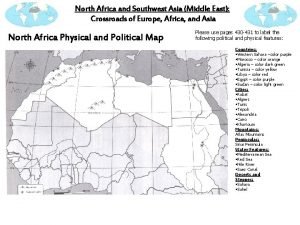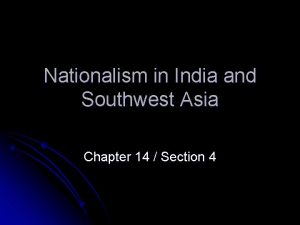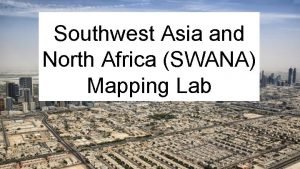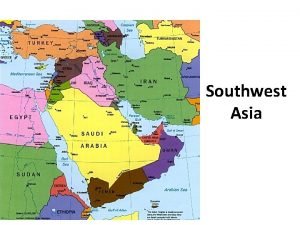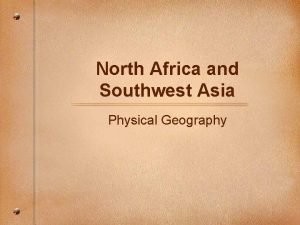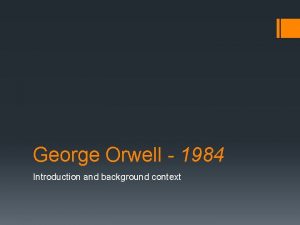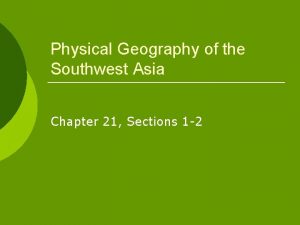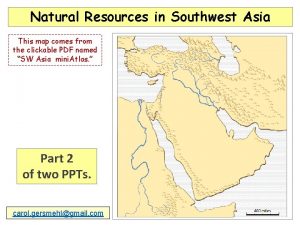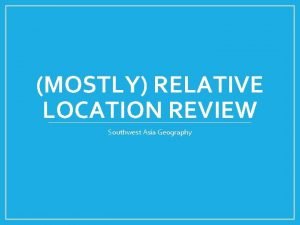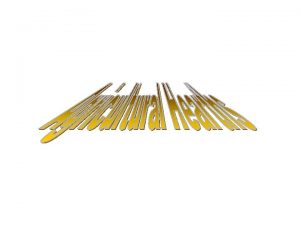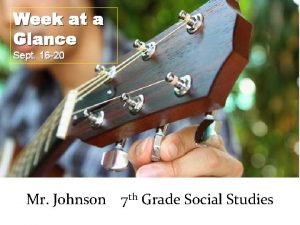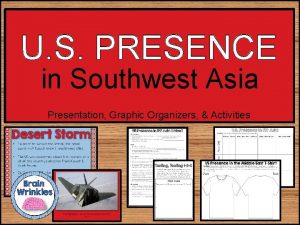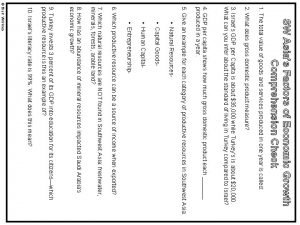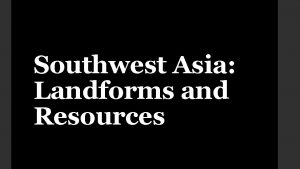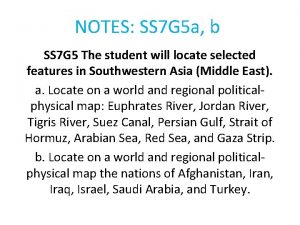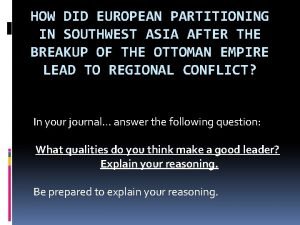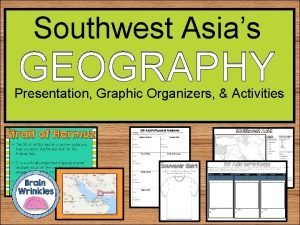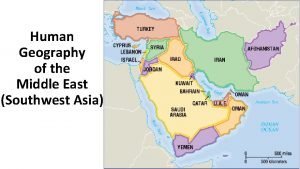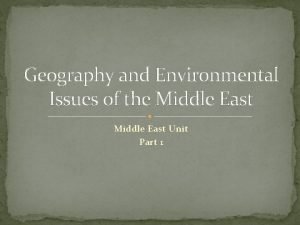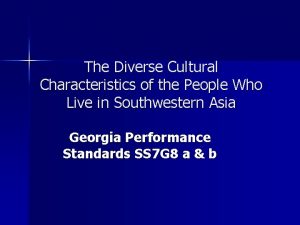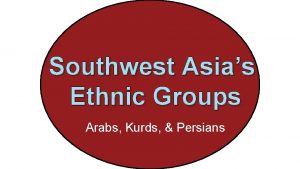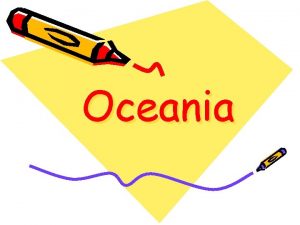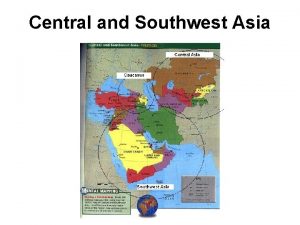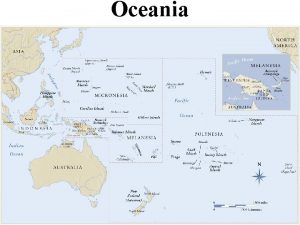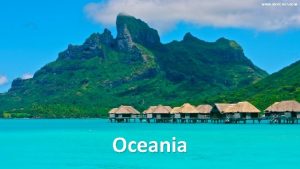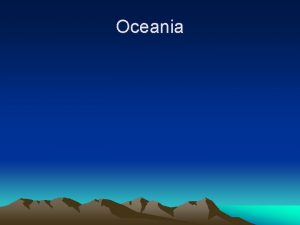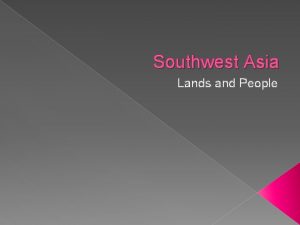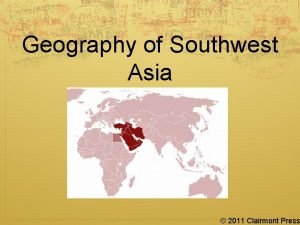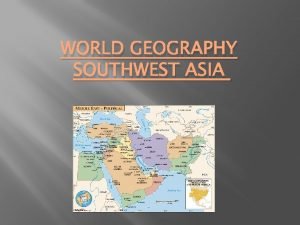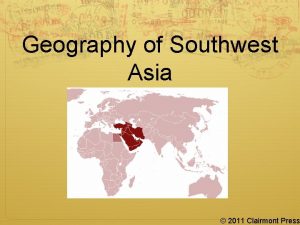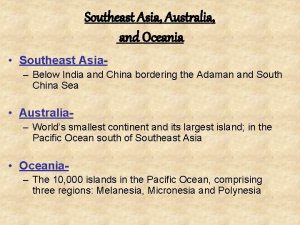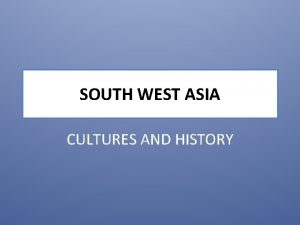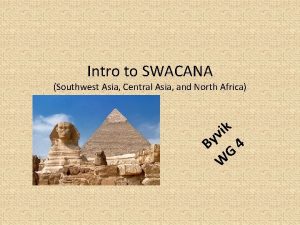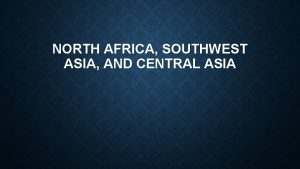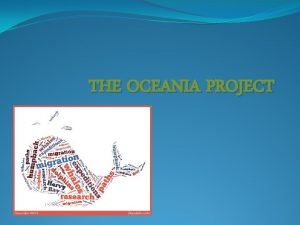Southwest Asia and Oceania Oceania Oceania is made


































- Slides: 34

Southwest Asia and Oceania

Oceania �Oceania is made up of 23 countries, spread over 10, 000 islands. �It covers over 3. 3 million square miles, but only has 0. 5 percent of the world’s population! �There is great diversity– everything from desert wilderness to tropical islands to active volcanos. �The area is divided into 3 main groups- Micronesia, Melanesia & Polynesia. �Australia is the largest island. Other major islands include New Zealand, Papua New Guinea and Fiji.

Southwest Asia

Mainland Islands • Southeast Asia consists of two distinct subregions: – Asian Mainland – Islands

Peninsulas and Islands • Two Peninsulas – Indochinese Peninsula – Malay Peninsula

Archipelagos • Philippines – 7, 000 islands • Indonesia – Over 13, 000 Islands

Southeast Asia Human Geography • History – Early History is patchwork of small kingdoms – European contact in the 1500 s • Colonized by the French – Independence in 1950 s • Cambodia and Vietnam became Communist • Vietnam war 1954 -1975 – Based on trying to contain communism – 1976 Communist North Won united the country under communism

Southeast Asia Human Geography • Religion – Most People are Muslims in Indonesia • About 90% are Muslim – Buddhism and Hinduism is practiced as well • Economics – Saw a boom in foreign investment 1980 s • Location and cheap labor helped • Resources – Rich in Mineral resources • Tin, Iron ore and Oil

The Land Down Under Oceania

AUSTRALIA • Sixth largest country (about the size of the US • Smallest & flattest continent • 2/3 classified as outback (hot & arid land) • Majority of population lives near the coast • Settled by European colonial powers such as Great Britain & France an island ~ a country ~ a continent

Climate v Australia has a temperate climate, which means there are many sunny days with mild temperatures. v Australia is located below the equator, so its seasons are opposite of ours. Summer is from December to March and winter is from June to August. v The coastal areas get plenty of rain, while the interior stays dry. v The outback is warm during the day, but chilly at night.

Natural Resources o Many natural resources, such as uranium, natural gas & zinc, can be found along the coastline. o One of Australia’s largest natural resources is coal, which is used for energy. They produce enough to provide electricity for the island sell the rest. o Australia also has huge deposits of iron ore, (used to make steel) and gold (used to make coins and jewelry). o There are huge ranches in the Outback where sheep are raised to produce wool.

Geographic Features �Coral Sea � Located on the northeast coast of Australia � Covers more than 280, 00 square miles � Location of a major WW 2 battle � Home to many types of marine life

Geographic Features �Great Barrier Reef— �It is the largest coral reef system in the world �It is more than 1200 miles long (longer than the Great Wall of China! �It is located in the Coral Sea on the northeast coast

Geographic Features �Great Victoria Desert � Largest desert in Australia � Named for Queen Victoria of England by Ernest Giles, the first European to cross it

History § Australia was settled by Great Britain during the colonial period. § § § Explorers Missionaries Prisoners § Australian ports were a life-line. The Australian colonies were totally dependent on ships for supplies and news from the 'motherland', Great Britain.

Aborigines When settlers arrived, there were 750, 000 Aborigines, or native Australians, living on the continent. Today only 1% of Australia’s population is Aborigine.

Aborigines v These natives formed approximately 500 tribes, each associated with its own language and stretch of territory. v The Aborigines lived by hunting and gathering food. v They had a semi-nomadic lifestyle (which means they moved as they needed to for food sources). v Family units were vitally important, as all members of a tribe were related. v Each tribe was led by religious leaders, with no political chief or formal government, and was broken down into bands (hunting groups)

Aborigines v Spirituality and religion played a major role in the Aboriginal culture. v There were many myths and rituals connected to both the tribe's ancestors and the creators of the world, none of whom ever died but merged with the natural world and thus remained a part of the present. v These myths and rituals, were known as the Dreaming or the Dreamtime, and reflected a belief in the continuity of existence and harmony with the world. v They were also a source of inspiration for much aboriginal art, including paintings, carved objects, symbolic weapons and poetic chants


Aborigines v The settlers viewed the natives as barbarians, seizing tribal land and, in many cases, taking it by force. v Many Aborigines died of disease, starvation, cultural dislocation and neglect. v Today, there are fewer than 230, 000 Aborigines in Australia. v Only 39% finish a high school education, compared to 75% of nonindigenous students in Australia.


Australian Culture-- Language • Although Australians share a common language with Great Britain and America, they have a unique accent & vocabulary. e i s s u A

Australian Culture-- Religion § Religions in Australia reflect their heritage. § Over 70% claim to be Christian, with almost half being either Anglican or Catholic. § This goes back to the time when England sent Catholic prisoners from Ireland when Anglican missionaries came during colonization.

Economics q Australia has mixed economy and has the least government control. q Supply & demand determine the 3 economic questions: q What to produce? q How to produce it? q Whom to produce it for? q People can own their own businesses and produce what they want. q Their currency is the Australian dollar.

Economics q Australia’s economy was originally based on agriculture. q Mining coal and iron ore became important in the 1960’s.

Economics q Australia developed trade relations with China & Japan and are working to develop some free trade agreements. q They export coal, iron ore & wool. q Australia import most of their products from China & the U. S. q They import computers, machinery & petroleum.

Government Australia has a federal parliamentary democracy. § Federal: It has a central government with 6 state governments. § Parliamentary: The legislative branch makes the laws. § Democracy: Citizens are highly involved.

Oceania (Pacific Islands)

Oceania is the groupings of islands in the pacific that have populations who share a common cultural background. The large island in South East Asia are not part of Oceania, since they have not experienced the same amount of isolation and as a result share a closer bond with the rest of Asia. Oceania is divided into three regions: Micronesia, meaning “tiny islands, ” Melanesia, meaning “black islands, ” and Polynesia, meaning “many islands. ”

Isolation led to the development of more than 1, 200 languages in Oceania. European languages were brought by colonization. English is the chief language of Australia and New Zealand, although Australian English features special local idioms and words. Indigenous religions in the South Pacific region focus on the relationship between human beings and nature. Followers of these religions believe that all natural things have spirits and are interrelated. Christianity, brought by Europeans, is the most widely practiced faith in the region today.

Literacy rates are high in Australia and New Zealand, where free education is compulsory to age 15. Both countries provide quality medical care. People who live in remote areas can take advantage of Australia’s Flying Doctor Service and its mobile clinics. Most Pacific Islanders still live in small villages. Generally, a chief leads each village. Usually, each extended family has a house or cluster of houses in the village. Village economies center on farming and fishing. Oceania has few cities, but those that exist have been growing.

Most of Oceania has an economy in which people work not for wages, but at subsistence activities. These are activities in which a family produces only the food, clothing, and shelter they themselves need. Agriculture and Tourism are the regions main economic activities. New Zealand earns much of its income by selling butter, cheese, meat, and wool to other countries, and is the world’s largest producer of kiwi fruit. Australia is the largest exporter of wool in the world. Much of Australia is arid, so only about ten percent of the land is used to grow crops. Australia earns much of its income from mining. Many mineral deposits lie in the outback. It is expensive to build roads and equip mines in these areas, so Australia has had to rely on foreign investors.

People in the South Pacific region enjoy a variety of traditional and European sports and leisure activities. Temperate or warm climates encourage people to enjoy many outdoor activities. Many islanders produce arts and crafts, such as baskets and mats woven from the leaves of palm trees or other plants. Carved wooden masks and utensils are also common.
 Colonial encounters in asia africa and oceania
Colonial encounters in asia africa and oceania Southwest asia
Southwest asia Southwest asia/north africa (swana) political map
Southwest asia/north africa (swana) political map Nationalism in india and southwest asia
Nationalism in india and southwest asia The sacred book of islam
The sacred book of islam Swana map
Swana map Kums definition geography
Kums definition geography Nationalism in india and southwest asia
Nationalism in india and southwest asia Nationalism in india and southwest asia
Nationalism in india and southwest asia Peninsulas and waterways in southwest asia
Peninsulas and waterways in southwest asia Southwest asia and north africa physical map
Southwest asia and north africa physical map North africa and southwest asia mountains
North africa and southwest asia mountains Where is oceania in 1984
Where is oceania in 1984 Brain wrinkles southwest asia
Brain wrinkles southwest asia Landforms of the southwest
Landforms of the southwest Map of southwest asia
Map of southwest asia Natural resources in southwest asia
Natural resources in southwest asia Iraq relative location
Iraq relative location Chapter 22 human geography of southwest asia
Chapter 22 human geography of southwest asia Agricultural hearths
Agricultural hearths Brain wrinkles southwest asia answer key
Brain wrinkles southwest asia answer key Voluntary trade comprehension check
Voluntary trade comprehension check Southwest asia comprehension check
Southwest asia comprehension check Site:slidetodoc.com
Site:slidetodoc.com Dubai landforms
Dubai landforms Tigris river on world map
Tigris river on world map Republic in southwest arabia
Republic in southwest arabia Europe partitioning in southwest asia answer key
Europe partitioning in southwest asia answer key Which physical features make trade easier?
Which physical features make trade easier? Is middle east in asia
Is middle east in asia Southwest asia map kuwait
Southwest asia map kuwait Which ethnic group is most numerous in southwest asia
Which ethnic group is most numerous in southwest asia Ethnic groups
Ethnic groups Why is water pollution a great concern in southwest asia
Why is water pollution a great concern in southwest asia Why is water pollution of great concern in southwest asia
Why is water pollution of great concern in southwest asia


